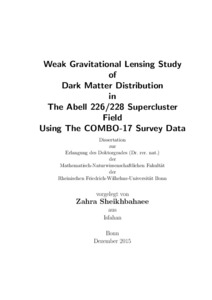Sheikhbahaee, Zahra: Weak Gravitational Lensing Study of Dark Matter Distribution in The Abell 226/228 Supercluster Field Using The COMBO-17 Survey Data. - Bonn, 2017. - Dissertation, Rheinische Friedrich-Wilhelms-Universität Bonn.
Online-Ausgabe in bonndoc: https://nbn-resolving.org/urn:nbn:de:hbz:5n-47621
Online-Ausgabe in bonndoc: https://nbn-resolving.org/urn:nbn:de:hbz:5n-47621
@phdthesis{handle:20.500.11811/7198,
urn: https://nbn-resolving.org/urn:nbn:de:hbz:5n-47621,
author = {{Zahra Sheikhbahaee}},
title = {Weak Gravitational Lensing Study of Dark Matter Distribution in The Abell 226/228 Supercluster Field Using The COMBO-17 Survey Data},
school = {Rheinische Friedrich-Wilhelms-Universität Bonn},
year = 2017,
month = jun,
note = {Accurate photometric calibration of optical data is crucial for photometric redshift estimation. We present the Softassign Procrustes Matching method (SPM) to improve the colour calibration upon the commonly used Stellar Locus Regression method (SLR) for the COMBO-17 survey. Our colour calibration approach can be categorized as a point-set matching method, which has frequently been used in medical imaging and pattern recognition. We attain a photometric redshift precision of better than 2 per cent. Our method is based on aligning the stellar locus of the uncalibrated stars to that of a synthetic standard stars catalogue. We achieve our goal by finding a correspondence-matrix between the two point-sets, and applying the matrix to estimate the appropriate translations in multi-dimensional colour space. The SPM method is able to find the translation between two point-sets, despite the existence of noise and incompleteness of the common structures in the sets, as long as there is a distinct structure in one of the colour-colour pairs. We demonstrate the precision of our colour calibration method with a mock catalogue. We additionally exploit a local point spread function (PSF) matching method to decrease the spatial variation of the PSF in the observed images.
According to the concordance Cold Dark Matter cosmological model, the large-scale structure filaments are slightly over-dense regions connecting clusters of galaxies in the universe. In the hierarchical structure formation model, clusters of galaxies grow through a sequence of mergers and continuous accreting of their surrounding matter. Filaments affect the properties of nearby clusters by funneling matters onto their haloes with a highly non-isotropic manner and along preferred directions. We report the weak lensing detection of at least three filaments between galaxy clusters at 0.3< z < 0.4. Using a deep R-band image from the 35'x35' MPG/ESO Wide Field Imager together with the accurate photometric redshifts of background galaxies from the COMBO-17 survey, we can identify weak lensing signals of filaments in different non-parametric mass reconstruction approaches. The shear profiles of the filamentary structures have > 2 sigma significance. We detect the galaxy clusters at the edges of the filaments using Cluster red-Sequence (CRS) method. Based on CRS approach, we identify fourteen clusters and groups and their corresponding brightest cluster galaxies (BCGs). We determine their masses and concentrations using Markov Chain Monte Carlo analysis by simultaneously fitting 14 Navarro-Frenk-White halos with fixing their centroids on their BCGs.},
url = {https://hdl.handle.net/20.500.11811/7198}
}
urn: https://nbn-resolving.org/urn:nbn:de:hbz:5n-47621,
author = {{Zahra Sheikhbahaee}},
title = {Weak Gravitational Lensing Study of Dark Matter Distribution in The Abell 226/228 Supercluster Field Using The COMBO-17 Survey Data},
school = {Rheinische Friedrich-Wilhelms-Universität Bonn},
year = 2017,
month = jun,
note = {Accurate photometric calibration of optical data is crucial for photometric redshift estimation. We present the Softassign Procrustes Matching method (SPM) to improve the colour calibration upon the commonly used Stellar Locus Regression method (SLR) for the COMBO-17 survey. Our colour calibration approach can be categorized as a point-set matching method, which has frequently been used in medical imaging and pattern recognition. We attain a photometric redshift precision of better than 2 per cent. Our method is based on aligning the stellar locus of the uncalibrated stars to that of a synthetic standard stars catalogue. We achieve our goal by finding a correspondence-matrix between the two point-sets, and applying the matrix to estimate the appropriate translations in multi-dimensional colour space. The SPM method is able to find the translation between two point-sets, despite the existence of noise and incompleteness of the common structures in the sets, as long as there is a distinct structure in one of the colour-colour pairs. We demonstrate the precision of our colour calibration method with a mock catalogue. We additionally exploit a local point spread function (PSF) matching method to decrease the spatial variation of the PSF in the observed images.
According to the concordance Cold Dark Matter cosmological model, the large-scale structure filaments are slightly over-dense regions connecting clusters of galaxies in the universe. In the hierarchical structure formation model, clusters of galaxies grow through a sequence of mergers and continuous accreting of their surrounding matter. Filaments affect the properties of nearby clusters by funneling matters onto their haloes with a highly non-isotropic manner and along preferred directions. We report the weak lensing detection of at least three filaments between galaxy clusters at 0.3< z < 0.4. Using a deep R-band image from the 35'x35' MPG/ESO Wide Field Imager together with the accurate photometric redshifts of background galaxies from the COMBO-17 survey, we can identify weak lensing signals of filaments in different non-parametric mass reconstruction approaches. The shear profiles of the filamentary structures have > 2 sigma significance. We detect the galaxy clusters at the edges of the filaments using Cluster red-Sequence (CRS) method. Based on CRS approach, we identify fourteen clusters and groups and their corresponding brightest cluster galaxies (BCGs). We determine their masses and concentrations using Markov Chain Monte Carlo analysis by simultaneously fitting 14 Navarro-Frenk-White halos with fixing their centroids on their BCGs.},
url = {https://hdl.handle.net/20.500.11811/7198}
}






